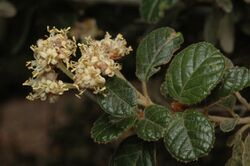Biology:Pomaderris eriocephala
| Pomaderris eriocephala | |
|---|---|

| |
| In the Australian National Botanic Gardens | |
| Scientific classification | |
| Kingdom: | Plantae |
| Clade: | Tracheophytes |
| Clade: | Angiosperms |
| Clade: | Eudicots |
| Clade: | Rosids |
| Order: | Rosales |
| Family: | Rhamnaceae |
| Genus: | Pomaderris |
| Species: | P. eriocephala
|
| Binomial name | |
| Pomaderris eriocephala N.A.Wakef.[1]
| |
Pomaderris eriocephala is a species of flowering plant in the family Rhamnaceae and is endemic to south-eastern continental Australia. It is a spreading shrub with hairy stems, egg-shaped leaves, and clusters of cream-coloured flowers with white to rust-coloured hairs.
Description
Pomaderris eriocephala is a spreading shrub that typically grows to a height of 1–3 m (3 ft 3 in–9 ft 10 in), its branchlets densely covered with shaggy, rust-coloured hairs. The leaves are egg-shaped, sometimes with the narrower end towards the base, and sometimes with a notched tip, 8–45 mm (0.31–1.77 in) long and 7–30 mm (0.28–1.18 in) wide, the upper surface with bristly hairs and the lower surface covered with white and rust-coloured, star-shaped hairs. The flowers are cream-coloured and borne in clusters about 10 mm (0.39 in) wide, each flower on a pedicel up to 10 mm (0.39 in) long with bracts at the base and covered with white to rust-coloured hairs. The floral cup is 1.0–1.5 mm (0.039–0.059 in) long, the sepals 1.6–2.3 mm (0.063–0.091 in) long but fall off as the flowers open, and there are usually no petals. Flowering occurs in September and October.[2][3][4]
Taxonomy
Pomaderris eriocephala was first formally described in 1951 by Norman Arthur Wakefield in The Victorian Naturalist from specimens he collected near the Upper Genoa River in 1949.[5][6] The specific epithet (eriocephala) means "wool-headed".[7]
Distribution and habitat
This pomaderris grows in forest and woodland, and is found from south of Barrington Tops along the coast, tablelands and western slopes of New South Wales, through the Australian Capital Territory to Bairnsdale in eastern Victoria.[2][3][4]
References
- ↑ "Pomaderris eriocephala". Australian Plant Census. https://biodiversity.org.au/nsl/services/apc-format/display/93750. Retrieved 11 February 2022.
- ↑ 2.0 2.1 Harden, Gwen J.. "Pomaderris eriocephala". Royal Botanic Garden Sydney. https://plantnet.rbgsyd.nsw.gov.au/cgi-bin/NSWfl.pl?page=nswfl&lvl=sp&name=Pomaderris~eriocephala.
- ↑ 3.0 3.1 Walsh, Neville G.. "Pomaderris eriocephala". Royal Botanic Gardens Victoria. https://vicflora.rbg.vic.gov.au/flora/taxon/d2a4f57e-217a-43ad-b0db-4b8a31f2bcdb.
- ↑ 4.0 4.1 Wood, Betty. "Pomaderris eriocephala". Lucid Keys. https://apps.lucidcentral.org/plants_se_nsw/text/entities/pomaderris_eriocephala.htm.
- ↑ "Pomaderris eriocephala". Australian Plant Name Index. https://biodiversity.org.au/nsl/services/rest/instance/apni/517188. Retrieved 11 February 2022.
- ↑ Wakefield, Norman A. (1951). "New species of Pomaderris". The Victorian Naturalist 68 (8): 141_142. https://www.biodiversitylibrary.org/item/127325#page/154/mode/1up. Retrieved 11 February 2022.
- ↑ Sharr, Francis Aubi; George, Alex (2019). Western Australian Plant Names and Their Meanings (3rd ed.). Kardinya, WA: Four Gables Press. p. 193. ISBN 9780958034180.
Wikidata ☰ Q17249494 entry
 |

